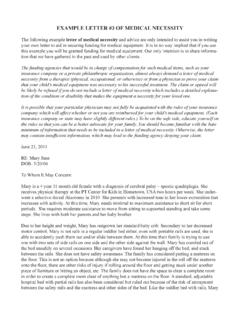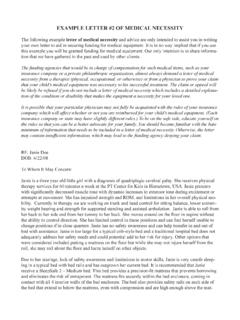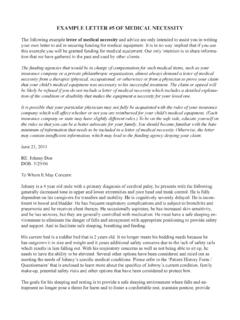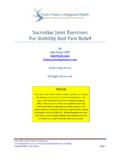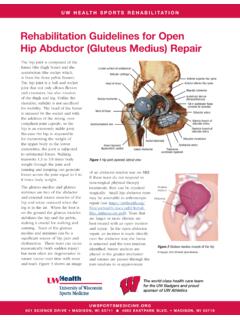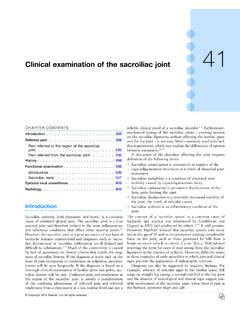Transcription of EXAMPLE LETTER #1 OF MEDICAL NECESSITY
1 EXAMPLE LETTER #1 OF MEDICAL NECESSITYThe following EXAMPLE LETTER of MEDICAL NECESSITY and advice are only intended to assist you in writing your own LETTER to aid in securing funding for MEDICAL equipment. It is in no way implied that if you use this EXAMPLE you will be granted funding for MEDICAL equipment. Our only intention is to share informa-tion that we have gathered in the past and used by other funding agencies that would be in charge of compensation for such MEDICAL items, such as your insurance company or a private philanthropic organization, almost always demand a LETTER of MEDICAL NECESSITY from a therapist (physical, occupational, or otherwise) or from a physician to prove your claim that your child s MEDICAL equipment was necessary to his successful treatment. The claim or appeal will be likely be refused if you do not include a LETTER of MEDICAL NECESSITY which includes a detailed explana-tion of the condition or disability that makes the equipment a NECESSITY for your loved one.
2 It is possible that your particular physician may not fully be acquainted with the rules of your insurance company which will affect whether or not you are reimbursed for your child s MEDICAL equipment. (Each insurance company or state may have slightly different rules.) To be on the safe side, educate yourself on the rules so that you can be a better advocate for your family. You should become familiar with the bare minimum of information that needs to be included in a LETTER of MEDICAL NECESSITY . Otherwise, the LETTER may contain insufficient information, which may lead to the funding agency denying your Justification May 4, 2011To Whom It May Concern (or, better, to a specific employee of the funding agency): RE: Johnny SmithDOB: 01/01/01 Patient Info:Johnny is a male, 11 years, 9 months old. Johnny lives at home with his mother and father.
3 His mother is his primary caregiver. He has a diagnosis of Pierre-Robin Syndrome and Trisomy 22. His MEDICAL his-tory includes: seizures, scoliosis, allergies, G-tube, limited vision and multiple hospitalizations. Medica-tion is taken for seizures and is 48 long (with knee flexion contractures) and weighs 60 pounds. He uses a manual wheelchair for dependent positioning and mobility. He sits with posterior pelvic tilt and rounded shoulders. Given trunk support he will take weight on his lower extremities to complete a standing pivot transfer. His cur-rent wheelchair seat height to floor is high, making transfers difficult. As he is getting heavier to transfer so we are actively working to improve his self transfer skills. He has limited active lower extremity movement using adaptive walking equipment. He has functional head and trunk control in sitting.
4 He has active floor mobility by scooting. He needs assistance to transition to/from the floor. He has low muscle tone and decreased muscle strength. Protective reactions are limited and he lacks safety aware-ness. Tight hamstrings affect his positioning. Johnny is dependent to all self-care activities. He is on con-tinuous feedings using a Situation:Johnny currently sleeps in a standard hospital bed with a manual crank for head adjustment. There is no foot or mattress height adjustment. The bed has partial safety rails at the shoulder and the foot sec-tion. Prior to the hospital bed, Johnny slept in a standard twin size bed. After numerous falls from the standard bed, he acquired a standard hospital bed. He has fallen from his current bed many times by sliding through the opening in the middle, unprotected section of the bed.
5 His mother has found Johnny entrapped in several different ways on numerous occasions with his limbs entangled within the openings of the partial safety rails. His current bed does not allow for foot adjustment so when his head is elevated for G-tube feedings he slides down the mattress, putting tension on his feeding tube. Wedges and pillows have been tried, but Johnny has been able to wiggle and kick them out of position. His current bed does not have mattress height adjustability, making self-transfers nearly impossible as the bed is too low for Johnny to bear weight and stand tall enough to transfer to his chair. Another option that was considered to prevent injury from falls or entrapment was to simply put a mattress on the floor, however this made it impossible for Johnny to be given the care necessary for his various conditions.
6 It would also prevent Johnny from being able to go from bed to chair for mobility and aid in his daily living. Similar special needs beds with safety rails were considered, such as the Stockton or a Pedicraft. However, these beds did not prove to be a lower cost alternative after adding the necessary options to the base model that would bring those beds up to the safety standards of the bed being recommended :We are recommending that Johnny obtain a SleepSafe 2 Medium Bed with Hi Lo foundation to ensure his safety. This bed provides a precision fit mattress that prevents burrowing and entrapment. The mat-tress is a Visco Elastic pressure relieving foam mattress which will assist in maintain his skin integrity. The full length safety rails prevent Johnny from falling from bed or becoming entrapped in them. The safety rails have clear non-breakable windows that allow freedom of visual interaction (needed to moni-tor his overall condition) and allows him a safe area when unsupervised.
7 The Hi Lo component of the electric foundation will allow the bed to be adjusted to the appropriate height that will allow Johnny to transfer by stand pivot. The adjustable head and foot component of the electric foundation allows his head to be elevated which will relieve spinal pressure, alleviate respiratory issues and is needed dur-ing continuous feeding through his G-tube. The adjustable foot section allows assistance in positioning Johnny when his head is elevated. Without the foot adjustment, he would continue to slide down the mattress surface, increasing the chance of displacement of his G-tube. An IV pole is needed for feeding Johnny. The SleepSafe 2 medium bed with hi lo foundation will allow Johnny to have a safe sleeping environment, assist in a self, stand pivot transfers from bed to chair and allow for proper positioning as he grows, without concerns of potential injury from falls or entrapment.
8 The features, solid construction and sufficient size of the bed will meet his needs for years to come, into his you for your time and consideration of Johnny s needs. If you have further questions I can be contacted at (555) ,Mary Johnson, PTBe sure to take note of when your child s LETTER was sent to the funding agency, and if three or four weeks pass without word from them, you might want to call the agency to inquire about the status of your claim. Always keep a record of when you call and with whom you speak to, and always try to remain calm and collected when dealing with the insurance company. If, however, you are unable to obtain a straightfor-ward response as to when your claim will be processed, do not hesitate to enlist the help of your physician.
